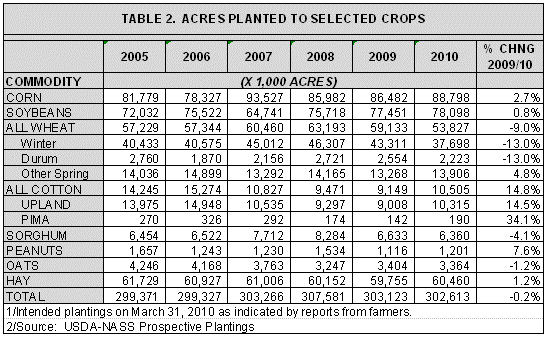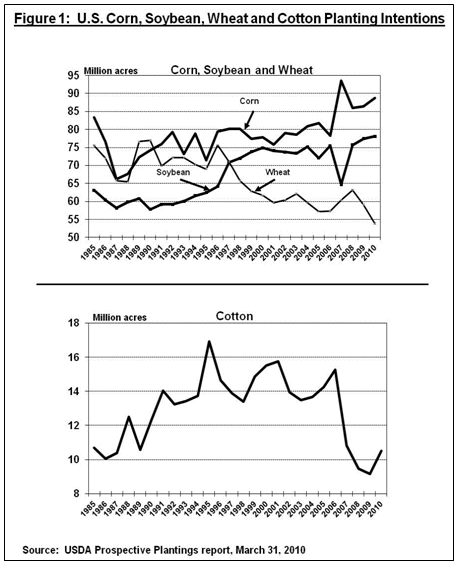Vol. 26, Issue 10, April 1, 2010 – PDF version
Jose G. Peña, Texas AgriLife Extension Economist-Management
The much anticipated U.S. planting intentions report, released on Wednesday, March 31, 2010, indicated that farmers intend to plant 2.7 percent more corn, 14.8 percent more cotton, 9.0 percent less wheat and slightly more soybeans than last year. (See figure 1, tables 1 and 2). While the report did not really surprise the industry, the estimated planting intentions of grains was lower than the market had anticipated. The report was generally market neutral-to-bearish for grains, soybeans and bullish for live and feeder cattle. But, the market remains fairly volatile.
 Futures prices for most grain commodity contracts traded lower on the report release date.
Futures prices for most grain commodity contracts traded lower on the report release date.
December ‘10 corn futures contracts closed at about $3.76/bu on Wednesday (3.31.10) down about six cents from the previous day and down about 32 cents from early March highs of about $4.08/bu.
The cotton market has been has been showing a steady improvement as supplies decrease. Prices for December ‘10 contracts, which will influence price discovery for the new, 2010/11 crop, were trading at about 74.9 cents/bu on Thursday (04.01.10), up slightly over six cents from early February lows of about 68.7 cents/lb.
July ‘10 wheat futures contracts in the Kansas City Board of Trade closed at about $4.73/bu. on the report release date, down about 18 cents/bu. from the previous day.
While the planting intentions report probably indicates that farmers are responding to lower market prices and high costs of production, final planting is still a ways into the future for much of the Corn Belt. The situation can and probably will change given the new planting numbers. Higher corn plantings appear probable.
Grain production and markets continue in a pivotal point in terms of the role of agriculture to help gain energy independence. Corn use for ethanol production now accounts for about 32.7 percent of this past season’s corn production of 13.1 billion bushels and will continue as the most significant activity affecting agriculture.
Corn/Sorghum
USDA’s initial planting intentions report indicated that corn growers intend to plant 88.798 million acres of corn, up 2.316 million acres (2.7%) from 86.482 million planted last year. According to USDA’s planting intention report, expected acreage is up in many States due to reduced winter wheat acreage and expectations of improved net returns. Acreage increases of 300,000 or more are expected in Illinois, Kansas, Missouri, and Ohio. The largest decreases are expected in Iowa, down 200,000 acres, and Texas, down 150,000 acres.
Using the historical corn acres harvested-to-planted ratio and the USDA’s February ’10 outlook Forum’s 2010/11 corn yield estimate of 160.9 bu./ac., corn production this season could approximate 13.13 billion bushels, about even with the 13.126 billion bushels produced this past season. Using USDA’s Outlook Forum’s total use estimate of 13.24 billion bushels demand, would exceed production by about 100 million bushels. Ending stocks could drop to about 1.69 billion bushels, down from projected stocks of 1.799 billion bushels.
While significantly lower than last year, the market is expected to remain at its current level. The situation is going to depend on actual plantings and weather. USDA’s Planting Intentions Report estimate is based on a survey of 86,000 farmers across the country which were asked, during the first two weeks on March, what they intend to plant this year. Figures of actual acres planted will be released during the end of June ‘10 and will form a major determinant of this season’s market. The weather and subsequent planting conditions between these two reports will be crucial.
In terms of the current market, grain stocks are up slightly from last year. USDA-NASS, March 31, 2010, Grain Stocks report indicated that corn stocks in all positions as of March 1, 2010 totaled 7.69 billion bushels, up eleven percent from March 1, 2009.
Sorghum farmers indicated that they intend to plant 6.36 million acres of sorghum, down 273,000 million acres (4.1%) from 6.633 million acres planted last year and down 23.2 percent from 8.284 million acres planted in 2008.
Soybean growers intend to plant an estimated 78.1 million acres, up about 647,000 acres from 77.451 million acres planted last year.
Cotton
The cotton market has been showing a steady improvement since last year’s lows. But, with over 90 percent of this past season’s production estimate as export bound, the market remains greatly affected by the global economic weakness.
All cotton plantings are expected to total 10.505 million acres (10.315 million upland; 190,000 Pima), up 14.8 percent last year but down 31.2 percent from 15.3 million acres planted in 2006. Upland area is expected to total 10.315 million acres, up 14.5 percent from last year.
Growers intend to increase planted area in all traditionally cotton producing states except Arkansas, Kansas, and Louisiana. The largest acreage increase was in Texas where producers intend to plant 600,000 acres more acres of upland cotton than in 2009. American-Pima cotton growers intend to increase their plantings by 34 percent from 2009 to 190,000 acres. California producers intend to plant 165,000 acres to Pima cotton, up 39 percent from last year.
Using the historical harvested-to-planted ratio and the estimate of average yields of the past six years of about 828 lbs/acre, production could approximate 16.43 million bales, up about 32.5 percent from 12.4 million bales produced this past season but down 23.9 percent from 21.59 million bales produced in 2006.
Using USDA’s total use projection for 2010/11 of 16 million bales, production will exceed the use estimate by 430,000 bales and would raise the estimate of new crop ending stocks to about 3.6 million bales, up from the March ‘10 estimate of this past season’s ending stock of 3.2 million bales.
Appreciation is expressed to Dr. J. Mark Welch, Assistant Professor & Extension Economist-Grain Marketing and Policy for his contribution to and review of this article.


